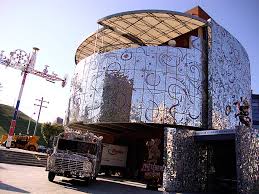[contextly_auto_sidebar id=”70PVqZFYlov39Dc4ArV5U7JAsBI1aSFb”]
Here’s a link to the talk I gave in Spain a couple of weeks ago, at an arts marketing conference that was both focused and fun. I mentioned the talk in my last post, about why I think the arts — as an industry that claims to represent art — are basically over.

Definitely not the Kennedy Center! The American Visionary Art Museum in Baltimore, one of my new arts model examples.
I didn’t put it that way in Madrid, instead talking about “old-model” vs. “new-model” arts, the old model being, well, the Kennedy Center in Washington, built on a grand scale, and deliberately placed off to the side of the city, to make sure it doesn’t come to close to everyday life. And offering, for its flagship presentations, the local orchestra and opera company.
The new model is very different. It offers art that mingles with the rest of the world, reflecting our current reality, which is that art springs up throughout our society, in places very far from the old, official arts.
But I won’t repeat that argument now. You can, again, read my last post for more on it. Or follow the link to my Madrid talk. What you’ll find is a PDF made from a greatly expanded version of the Keynote slides I used in my talk. (Something very welcome, at least to me: The conference was run on Macs.) The slides were originally designed to reinforce what I was saying in my talk. Now I’ve rewritten them to stand alone.
What you’ll find, if you read the PDF:
An introduction, about the opening event of the new Kennedy Center season, offered as an example of everything the arts have traditionally been, and can’t be in the future. (Not if we want them to survive.)
Then a look at what’s wrong with the old model. It’s wrong on a human level, because it excludes people. It’s wrong artistically, because it excludes most of the art of our time. It’s wrong politically, and wrong from a business point of view (because it neglects much of our potential audience). And it’s not sustainable.
Then the new model, in which we join the rest of the world.
And then some points about marketing the new model, which can only be done by becoming part of the rest of the world, and going out to look for our new audience where they live, work, and play. They’re not coming to us, that’s for sure! So — with, as I said, fear and trembling, because I’m not a marketer — I offered examples of word of mouth marketing.
And then my conclusion, which I have to admit I’m crazy happy with. I’ve realized for quite a while that I talk a lot about populist appeal. Which I very much believe in! I don’t think we can have healthy art — or a healthy arts business — if it’s not founded on things that people like. Which doesn’t mean dumb things. It means things that fit our current culture.
One thing I learned during my years in the pop music business (as chief pop critic for the Los Angelels Herald-Examiner, during the last two years it existed, and then as music critic and music editor of Entertainment Weekly) — a huge market has huge fringes. So if much of the art I like tends to be out on the fringe, what I found in pop music was that, due to the massive size of the entire market, vastly more people were listening to it than listened to the out-there stuff I might like in classical music.
But I don’t think I talk enough about my taste in art, and how a lot of what I love (Webern, for instance, or Antonioni’s films) isn’t populist at all. In my Madrid talk, I managed to bring the two sides of me together, maybe for the first time.
So let me end by quoting the end of my presentation, as you’ll read it in the PDF:
And now to conclude…
Let me take a step backward.
I’ll ask you again:
What is your ultimate marketing goal?
I think it should be…
To attract people to whatever art you want to present.
To do that, you have to be bold.
Here are two famous quotes about being bold, from:
- Steve Jobs, who made Apple the triumphant company it is now
- Diana Vreeland, who as editor of Vogue magazine was a leader in both fashion and magazine publishing
- And who became the first curator at the Costume Institute of the Metropolitan Museum of Art
Steve Jobs said:
- “People don’t know what they want until you show it to them.”
Diana Vreeland said:
- “You’re not supposed to give people what they want. You’re supposed to give them what they don’t know they want yet.”
So in the end…
We’re back to the timeless model of the arts.
- Art should be new
- Art should be revelatory
- Art should take the lead
And that’s where we have to be…
- But we can’t take the lead until we’re in the race
- We won’t be in the race until we’re in contact with our current culture
- And that’s why we have to join the rest of the world
